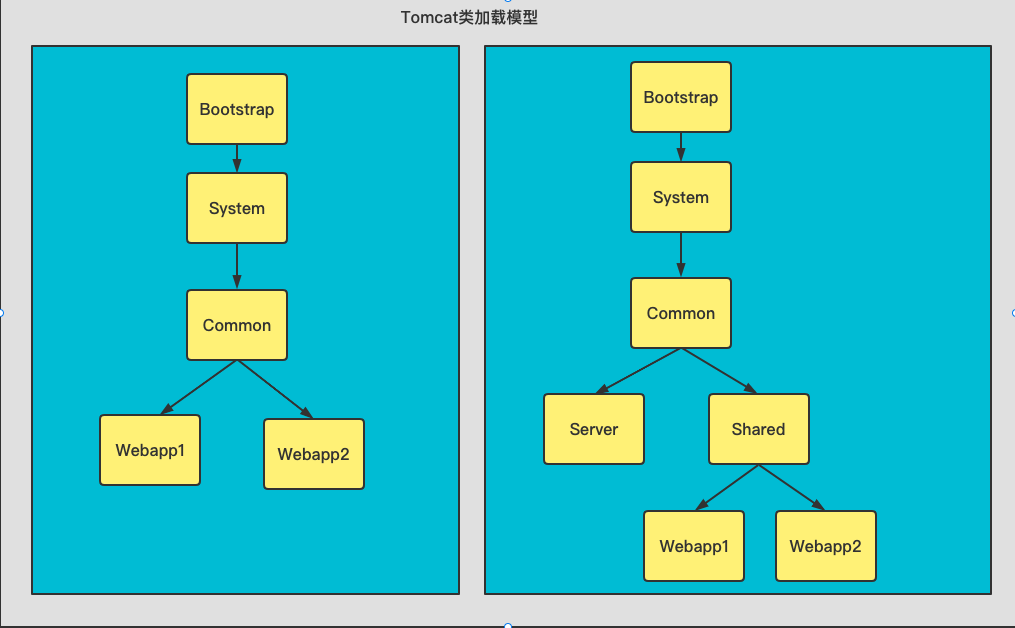Tomcat 启动流程
Tomcat 启动流程
# Tomcat启动流程
有第一篇文章 Tomcat的源码编译 ,我们知道在启动
配置的的时候,MainClass 配置的地址就是org.apache.catalina.startup.Bootstrap,所有要想研究Tomcat的启动流程,那么
就得研究一下这个类。
# 类Bootstrap执行流程
将核心的几个方法进行提取。
# 初始化
bootstrap.init()方法,初始化类加载器。
public void init() throws Exception {
// 初始化类加载器
initClassLoaders();
Thread.currentThread().setContextClassLoader(catalinaLoader);
SecurityClassLoad.securityClassLoad(catalinaLoader);
if (log.isDebugEnabled()) {
log.debug("Loading startup class");
}
// 加载 Catalina 类 创建实例,调用setParentClassLoader 为什么要用反射?
// catalinaLoader.loadClass 可以决定使用那个类加载器
// 当前加载的Bootstrap 的类加载器是 system class loader
// 若通过反射加载,org.apache.catalina.startup.Catalina就在catalinaLoader
Class<?> startupClass = catalinaLoader.loadClass("org.apache.catalina.startup.Catalina");
//反射创建实例
Object startupInstance = startupClass.getConstructor().newInstance();
if (log.isDebugEnabled()) {
log.debug("Setting startup class properties");
}
// 方法签名
String methodName = "setParentClassLoader";
//构建参数类型
Class<?> paramTypes[] = new Class[1];
paramTypes[0] = Class.forName("java.lang.ClassLoader");
Object paramValues[] = new Object[1];
paramValues[0] = sharedLoader;
Method method =
startupInstance.getClass().getMethod(methodName, paramTypes);
method.invoke(startupInstance, paramValues);
catalinaDaemon = startupInstance;
}
2
3
4
5
6
7
8
9
10
11
12
13
14
15
16
17
18
19
20
21
22
23
24
25
26
27
28
29
30
# 类加载initClassLoaders
首先我们来看一下Tomcat中的类加载模型,有俩种,如下图:

由图可知,类加载有俩种模型,左边的是默认的类加载过程,右边的是做了隔离的类加载过程。左边是
Tomcat和应用共享库 ,右边的可以决定是否要共享库。
private void initClassLoaders() {
try {
// 创建common类加载器
commonLoader = createClassLoader("common", null);
if (commonLoader == null) {
//若common类加载为空着取当前的类加载器
commonLoader = this.getClass().getClassLoader();
}
catalinaLoader = createClassLoader("server", commonLoader);
sharedLoader = createClassLoader("shared", commonLoader);
} catch (Throwable t) {
handleThrowable(t);
log.error("Class loader creation threw exception", t);
System.exit(1);
}
}
2
3
4
5
6
7
8
9
10
11
12
13
14
15
16
由以上代码可知,有一个创建的类加载器的方法,那么各个类型的类加载器都做了什么。我们分析一下这个方法。
// 创建类加载器
private ClassLoader createClassLoader(String name, ClassLoader parent) throws Exception {
//配置文件中获取类加载器
String value = CatalinaProperties.getProperty(name + ".loader");
//若当前类加载器是空的,则返回父类加载器
if ((value == null) || (value.equals(""))) {
return parent;
}
value = replace(value);
List<Repository> repositories = new ArrayList<>();
String[] repositoryPaths = getPaths(value);
for (String repository : repositoryPaths) {
// Check for a JAR URL repository
try {
@SuppressWarnings("unused")
URL url = new URL(repository);
repositories.add(new Repository(repository, RepositoryType.URL));
continue;
} catch (MalformedURLException e) {
// Ignore
}
// Local repository
if (repository.endsWith("*.jar")) {
repository = repository.substring
(0, repository.length() - "*.jar".length());
repositories.add(new Repository(repository, RepositoryType.GLOB));
} else if (repository.endsWith(".jar")) {
repositories.add(new Repository(repository, RepositoryType.JAR));
} else {
repositories.add(new Repository(repository, RepositoryType.DIR));
}
}
return ClassLoaderFactory.createClassLoader(repositories, parent);
}
2
3
4
5
6
7
8
9
10
11
12
13
14
15
16
17
18
19
20
21
22
23
24
25
26
27
28
29
30
31
32
33
34
35
36
37
38
39
40
# 加载
bootstrap.load()方法,该方法只是一个代理,来代理Catalina类,间接调用 Catalina,创建对象树后,然后
调用生命周期的init方法初始化整个对象树。
private void load(String[] arguments) throws Exception {
// Call the load() method
String methodName = "load";
Object param[];
Class<?> paramTypes[];
if (arguments==null || arguments.length==0) {
paramTypes = null;
param = null;
} else {
paramTypes = new Class[1];
paramTypes[0] = arguments.getClass();
param = new Object[1];
param[0] = arguments;
}
Method method =
catalinaDaemon.getClass().getMethod(methodName, paramTypes);
if (log.isDebugEnabled()) {
log.debug("Calling startup class " + method);
}
method.invoke(catalinaDaemon, param);
}
2
3
4
5
6
7
8
9
10
11
12
13
14
15
16
17
18
19
20
21
22
# 启动
bootstrap.start()方法,该方法只是一个代理,来代理Catalina类,间接调用 Catalina,创建对象树后,然后
启动生命周期的start方法启动整个对象树。
public void start() throws Exception {
// 必须先初始化Catalina
if (catalinaDaemon == null) {
init();
}
// 直接调用catalina的start
Method method = catalinaDaemon.getClass().getMethod("start", (Class [])null);
method.invoke(catalinaDaemon, (Object [])null);
}
2
3
4
5
6
7
8
9
# 停止
bootstrap.stop()方法,该方法只是一个代理,来代理Catalina类,间接调用 Catalina,创建对象树后,然后
停止生命周期的stop方法启动整个对象树。
public void stop() throws Exception {
Method method = catalinaDaemon.getClass().getMethod("stop", (Class []) null);
method.invoke(catalinaDaemon, (Object []) null);
}
2
3
4
# 类Catalina原理
# load 加载方法:
创建对象树,然后调用init化方法进行初始化操作
public void load() {
//只允许被加载一次
if (loaded) {
return;
}
loaded = true;
long t1 = System.nanoTime();
// 遗留代码
initDirs();
// JNDI 操作 目前的云原生不会用到
initNaming();
// 创建砸蛋器,自动创建组件树
Digester digester = createStartDigester();
InputSource inputSource = null;
InputStream inputStream = null;
File file = null;
try {
try {
file = configFile();
inputStream = new FileInputStream(file);
inputSource = new InputSource(file.toURI().toURL().toString());
} catch (Exception e) {
if (log.isDebugEnabled()) {
log.debug(sm.getString("catalina.configFail", file), e);
}
}
// 构建 server.xml 组件树流
if (inputStream == null) {
try {
inputStream = getClass().getClassLoader()
.getResourceAsStream(getConfigFile());
inputSource = new InputSource
(getClass().getClassLoader()
.getResource(getConfigFile()).toString());
} catch (Exception e) {
if (log.isDebugEnabled()) {
log.debug(sm.getString("catalina.configFail",
getConfigFile()), e);
}
}
}
if (inputStream == null) {
try {
inputStream = getClass().getClassLoader()
.getResourceAsStream("server-embed.xml");
inputSource = new InputSource
(getClass().getClassLoader()
.getResource("server-embed.xml").toString());
} catch (Exception e) {
if (log.isDebugEnabled()) {
log.debug(sm.getString("catalina.configFail",
"server-embed.xml"), e);
}
}
}
if (inputStream == null || inputSource == null) {
if (file == null) {
log.warn(sm.getString("catalina.configFail",
getConfigFile() + "] or [server-embed.xml]"));
} else {
log.warn(sm.getString("catalina.configFail",
file.getAbsolutePath()));
if (file.exists() && !file.canRead()) {
log.warn("Permissions incorrect, read permission is not allowed on the file.");
}
}
return;
}
try {
inputSource.setByteStream(inputStream);
digester.push(this);
// server.xml 定义的整个对象树和监听器都会按照digester的规则创建完成
digester.parse(inputSource);
} catch (SAXParseException spe) {
log.warn("Catalina.start using " + getConfigFile() + ": " +
spe.getMessage());
return;
} catch (Exception e) {
log.warn("Catalina.start using " + getConfigFile() + ": " , e);
return;
}
} finally {
if (inputStream != null) {
try {
inputStream.close();
} catch (IOException e) {
// Ignore
}
}
}
// 设置server对象的属性
getServer().setCatalina(this);
getServer().setCatalinaHome(Bootstrap.getCatalinaHomeFile());
getServer().setCatalinaBase(Bootstrap.getCatalinaBaseFile());
// 重定向系统 输入输出流
initStreams();
// Start the new server
// 进入整个对象树生命周期流程
try {
//初始化
getServer().init();
} catch (LifecycleException e) {
if (Boolean.getBoolean("org.apache.catalina.startup.EXIT_ON_INIT_FAILURE")) {
throw new java.lang.Error(e);
} else {
log.error("Catalina.start", e);
}
}
long t2 = System.nanoTime();
if(log.isInfoEnabled()) {
log.info("Initialization processed in " + ((t2 - t1) / 1000000) + " ms");
}
}
2
3
4
5
6
7
8
9
10
11
12
13
14
15
16
17
18
19
20
21
22
23
24
25
26
27
28
29
30
31
32
33
34
35
36
37
38
39
40
41
42
43
44
45
46
47
48
49
50
51
52
53
54
55
56
57
58
59
60
61
62
63
64
65
66
67
68
69
70
71
72
73
74
75
76
77
78
79
80
81
82
83
84
85
86
87
88
89
90
91
92
93
94
95
96
97
98
99
100
101
102
103
104
105
106
107
108
109
110
111
112
113
114
115
116
117
118
119
120
121
122
Digester可以将 server.xml的配置的组件树的对象树进行创建,并且将各个组件的配置进行配置完成。这样的话整个
对象树就进行了自动创建。
//根据 传如的server.xml 创建tomcat的组件 包括 server service
protected Digester createStartDigester() {
long t1=System.currentTimeMillis();
// Initialize the digester
Digester digester = new Digester();
digester.setValidating(false);
digester.setRulesValidation(true);
Map<Class<?>, List<String>> fakeAttributes = new HashMap<>();
List<String> objectAttrs = new ArrayList<>();
objectAttrs.add("className");
fakeAttributes.put(Object.class, objectAttrs);
// Ignore attribute added by Eclipse for its internal tracking
List<String> contextAttrs = new ArrayList<>();
contextAttrs.add("source");
fakeAttributes.put(StandardContext.class, contextAttrs);
digester.setFakeAttributes(fakeAttributes);
digester.setUseContextClassLoader(true);
// Configure the actions we will be using
digester.addObjectCreate("Server",
"org.apache.catalina.core.StandardServer",
"className");
digester.addSetProperties("Server");
digester.addSetNext("Server",
"setServer",
"org.apache.catalina.Server");
digester.addObjectCreate("Server/GlobalNamingResources",
"org.apache.catalina.deploy.NamingResourcesImpl");
digester.addSetProperties("Server/GlobalNamingResources");
digester.addSetNext("Server/GlobalNamingResources",
"setGlobalNamingResources",
"org.apache.catalina.deploy.NamingResourcesImpl");
digester.addObjectCreate("Server/Listener",
null, // MUST be specified in the element
"className");
digester.addSetProperties("Server/Listener");
digester.addSetNext("Server/Listener",
"addLifecycleListener",
"org.apache.catalina.LifecycleListener");
digester.addObjectCreate("Server/Service",
"org.apache.catalina.core.StandardService",
"className");
digester.addSetProperties("Server/Service");
digester.addSetNext("Server/Service",
"addService",
"org.apache.catalina.Service");
digester.addObjectCreate("Server/Service/Listener",
null, // MUST be specified in the element
"className");
digester.addSetProperties("Server/Service/Listener");
digester.addSetNext("Server/Service/Listener",
"addLifecycleListener",
"org.apache.catalina.LifecycleListener");
//Executor
digester.addObjectCreate("Server/Service/Executor",
"org.apache.catalina.core.StandardThreadExecutor",
"className");
digester.addSetProperties("Server/Service/Executor");
digester.addSetNext("Server/Service/Executor",
"addExecutor",
"org.apache.catalina.Executor");
digester.addRule("Server/Service/Connector",
new ConnectorCreateRule());
digester.addRule("Server/Service/Connector",
new SetAllPropertiesRule(new String[]{"executor", "sslImplementationName"}));
digester.addSetNext("Server/Service/Connector",
"addConnector",
"org.apache.catalina.connector.Connector");
digester.addObjectCreate("Server/Service/Connector/SSLHostConfig",
"org.apache.tomcat.util.net.SSLHostConfig");
digester.addSetProperties("Server/Service/Connector/SSLHostConfig");
digester.addSetNext("Server/Service/Connector/SSLHostConfig",
"addSslHostConfig",
"org.apache.tomcat.util.net.SSLHostConfig");
digester.addRule("Server/Service/Connector/SSLHostConfig/Certificate",
new CertificateCreateRule());
digester.addRule("Server/Service/Connector/SSLHostConfig/Certificate",
new SetAllPropertiesRule(new String[]{"type"}));
digester.addSetNext("Server/Service/Connector/SSLHostConfig/Certificate",
"addCertificate",
"org.apache.tomcat.util.net.SSLHostConfigCertificate");
digester.addObjectCreate("Server/Service/Connector/SSLHostConfig/OpenSSLConf",
"org.apache.tomcat.util.net.openssl.OpenSSLConf");
digester.addSetProperties("Server/Service/Connector/SSLHostConfig/OpenSSLConf");
digester.addSetNext("Server/Service/Connector/SSLHostConfig/OpenSSLConf",
"setOpenSslConf",
"org.apache.tomcat.util.net.openssl.OpenSSLConf");
digester.addObjectCreate("Server/Service/Connector/SSLHostConfig/OpenSSLConf/OpenSSLConfCmd",
"org.apache.tomcat.util.net.openssl.OpenSSLConfCmd");
digester.addSetProperties("Server/Service/Connector/SSLHostConfig/OpenSSLConf/OpenSSLConfCmd");
digester.addSetNext("Server/Service/Connector/SSLHostConfig/OpenSSLConf/OpenSSLConfCmd",
"addCmd",
"org.apache.tomcat.util.net.openssl.OpenSSLConfCmd");
digester.addObjectCreate("Server/Service/Connector/Listener",
null, // MUST be specified in the element
"className");
digester.addSetProperties("Server/Service/Connector/Listener");
digester.addSetNext("Server/Service/Connector/Listener",
"addLifecycleListener",
"org.apache.catalina.LifecycleListener");
digester.addObjectCreate("Server/Service/Connector/UpgradeProtocol",
null, // MUST be specified in the element
"className");
digester.addSetProperties("Server/Service/Connector/UpgradeProtocol");
digester.addSetNext("Server/Service/Connector/UpgradeProtocol",
"addUpgradeProtocol",
"org.apache.coyote.UpgradeProtocol");
// Add RuleSets for nested elements
digester.addRuleSet(new NamingRuleSet("Server/GlobalNamingResources/"));
digester.addRuleSet(new EngineRuleSet("Server/Service/"));
digester.addRuleSet(new HostRuleSet("Server/Service/Engine/"));
digester.addRuleSet(new ContextRuleSet("Server/Service/Engine/Host/"));
addClusterRuleSet(digester, "Server/Service/Engine/Host/Cluster/");
digester.addRuleSet(new NamingRuleSet("Server/Service/Engine/Host/Context/"));
// When the 'engine' is found, set the parentClassLoader.
digester.addRule("Server/Service/Engine",
new SetParentClassLoaderRule(parentClassLoader));
addClusterRuleSet(digester, "Server/Service/Engine/Cluster/");
long t2=System.currentTimeMillis();
if (log.isDebugEnabled()) {
log.debug("Digester for server.xml created " + ( t2-t1 ));
}
return digester;
}
2
3
4
5
6
7
8
9
10
11
12
13
14
15
16
17
18
19
20
21
22
23
24
25
26
27
28
29
30
31
32
33
34
35
36
37
38
39
40
41
42
43
44
45
46
47
48
49
50
51
52
53
54
55
56
57
58
59
60
61
62
63
64
65
66
67
68
69
70
71
72
73
74
75
76
77
78
79
80
81
82
83
84
85
86
87
88
89
90
91
92
93
94
95
96
97
98
99
100
101
102
103
104
105
106
107
108
109
110
111
112
113
114
115
116
117
118
119
120
121
122
123
124
125
126
127
128
129
130
131
132
133
134
135
136
137
138
139
140
141
142
# start 启动方法:
创建对象树,然后启动生命周期的start方法启动整个对象树。
public void start() {
//先初始化
if (getServer() == null) {
load();
}
if (getServer() == null) {
log.fatal("Cannot start server. Server instance is not configured.");
return;
}
long t1 = System.nanoTime();
//启动生命周期中的start
try {
getServer().start();
} catch (LifecycleException e) {
log.fatal(sm.getString("catalina.serverStartFail"), e);
try {
getServer().destroy();
} catch (LifecycleException e1) {
log.debug("destroy() failed for failed Server ", e1);
}
return;
}
long t2 = System.nanoTime();
if(log.isInfoEnabled()) {
log.info("Server startup in " + ((t2 - t1) / 1000000) + " ms");
}
// JVM退出钩子
if (useShutdownHook) {
if (shutdownHook == null) {
shutdownHook = new CatalinaShutdownHook();
}
Runtime.getRuntime().addShutdownHook(shutdownHook);
LogManager logManager = LogManager.getLogManager();
if (logManager instanceof ClassLoaderLogManager) {
((ClassLoaderLogManager) logManager).setUseShutdownHook(
false);
}
}
// 主线程等待关闭信号
if (await) {
await();
stop();
}
}
2
3
4
5
6
7
8
9
10
11
12
13
14
15
16
17
18
19
20
21
22
23
24
25
26
27
28
29
30
31
32
33
34
35
36
37
38
39
40
41
42
43
44
45
46
47
48
49
50
# stop 停止方法:
该方法。将组件停止,并且进行销毁。
public void stop() {
try {
if (useShutdownHook) {
Runtime.getRuntime().removeShutdownHook(shutdownHook);
LogManager logManager = LogManager.getLogManager();
if (logManager instanceof ClassLoaderLogManager) {
((ClassLoaderLogManager) logManager).setUseShutdownHook(
true);
}
}
} catch (Throwable t) {
ExceptionUtils.handleThrowable(t);
}
try {
Server s = getServer();
LifecycleState state = s.getState();
if (LifecycleState.STOPPING_PREP.compareTo(state) <= 0
&& LifecycleState.DESTROYED.compareTo(state) >= 0) {
} else {
s.stop();
s.destroy();
}
} catch (LifecycleException e) {
log.error("Catalina.stop", e);
}
}
2
3
4
5
6
7
8
9
10
11
12
13
14
15
16
17
18
19
20
21
22
23
24
25
26
27
# 小结
以上就是整个Tomcat的启动流程,其实就是用Bootstrap类的init、start、stop的这些方法,来代理
Catalina的这写方法进行相应的操作。所以说Tomcat的核心是Catalina,其中有一个小工具Digester 官网地址是
一个很有意思的工具,我们平时在工作中解析XML的时候可以考虑使用这个小工具。

